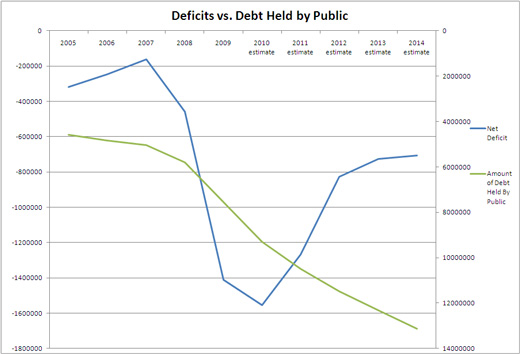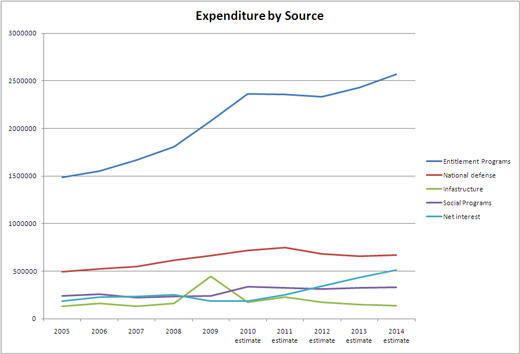Receipts
Personal Income Tax Since the passage of the Sixteenth Amendment in 1913, the personal income tax has provided the federal government’s single largest source of revenue. The tax consists of six brackets, levying progressively higher rates on higher levels of income. For example, a taxpayer earning $5,000 of taxable income per year would pay only 10%, or $500, of his income. A taxpayer earning $50,000 would pay 10% of the first $8,375 of income, plus 15% of the next $25,624 (which is $34,000 – $8,376), plus 25% of the last $16,000, for a total liability of $8,681.10. The following chart contains the fiscal year 2010 rates for single filers; note that different rates apply for married couples and heads of households.
| Marginal Tax Rate | Applies to income between |
| 10% | $0 to $8,375 |
| 15% | $8,376 to $34,000 |
| 25% | $34,001 to $82,400 |
| 28% | $82,401 to 171,850 |
| 33% | $171,851 to $373,650 |
| 35% | Above $373,651 |
Corporate Tax In addition to the income tax, the United States collects a progressive tax on corporate income at approximately similar rates. At 35%, the top bracket is the developed world’s second highest corporate tax rate. Revenues from the tax vary wildly during recessions, illustrated most recently by the halving of receipts from 2008 to 2009.
Payroll Tax The Federal Insurance Contributions Act tax, or FICA, funds two major entitlements, Social Security and Medicare Part A. The Social Security tax consists of two levees: one 6.2% tax on the first $106,800 of compensation from every employee, and a matching amount from the employer, for an effective 12.4% tax. Medicare costs both employer and employee 1.45%, for a total tax of 2.9%; this rate is scheduled to increase for individuals earning more than $200,000 per year as part of the Patient Protection and Affordable Care Act. Self-employed people pay the full 15.3%—both the employer and the employee share. Smaller payroll taxes support unemployment insurance and retraining of displaced workers.
Excise Taxes Once the federal government’s sole source of revenue, tariffs and domestic excise taxes, such as those on gasoline and cigarettes and the recently enacted tax on the use of indoor tanning beds, now comprise a miniscule portion of federal receipts.
Estate Tax The federal government has for decades levied an estate tax on the wealth of deceased persons, as well as a gift tax on property transfers to prevent avoidance of the estate tax by giving away one’s property before death. The estate tax is at 0% in 2010, having been phased out by the 2001 Bush tax cut, but is scheduled to revert to a 55% levy on all wealth in excess of $1 million at the beginning of 2011.
Other As the owner of large portions of land throughout the United States, particularly in the West and Southwest, the federal government derives funds from the sale of property. Other revenue sources range from passport processing fees to voluntary donations to the federal purse.
Expenditures
Social Security The largest government program by dollar expenditure, Social Security has been a pillar of the federal budget since the 1930s. The program transfers income from current workers to retirees, orphans, persons with disabilities, and others. Its long-term solvency is uncertain. SEE ARTICLE
Medicare Created in the 1960s to provide health insurance to the elderly, Medicare remains one of the most visible and politically popular functions of the federal government. It has doubled in size over the past decade and shows no sign of slowing.
Medicaid A part of Lyndon Johnson’s Great Society, Medicaid offers health insurance to the poor who are too young to qualify for Medicare. It is administered individually by each state; the federal government sets national standards and doles out funding according to its Federal Matching Assistance Percentages guidelines.
Other Health Care Programs From the State Children’s Health Insurance Program to the Food and Drug Administration, the federal government does a great deal in health care outside the two major entitlement programs.
Unemployment Insurance Under the Federal Unemployment Tax Act, newly unemployed citizens receive a certain fraction of their previous wages for a period of time. A so-called automatic stabilizer, costs peak during recessions. While unemployment insurance typically grants benefits for 26 weeks, Congress has extended the program to some 99 weeks as a result of the current economic downturn.
Other Welfare Programs Food Stamps, Housing Assistance, Temporary Assistance to Needy Families, and smaller safety net programs such as job retraining and funding for social workers supplement welfare at the state level.
Federal Employee Retirement Benefits Pensions for past generations of government workers is likely to become a more significant budget item in the coming years. FERB represents the number of retired employees, times the average benefit paid to each, an amount that will grow exponentially as the Baby Boom generation passes age 65 beginning in 2011 and as life expectancy continues to increase.
Veterans’ Benefits The Department of Veterans’ Affairs provides a series of benefits for America’s service members, including heavily subsidized health care, college tuition benefits, and pensions.
National Defense America’s military remains by far the world’s largest in terms of absolute spending and ranks in the top 12 as a percentage of GDP. SEE ARTICLE
Wars in Iraq and Afghanistan The budgetary allocation for the wars in Iraq and Afghanistan and other post-9/11 operations has been roughly $1.15 trillion over the past decade. No precise data is available beyond 2010, as outlays will depend on policy choices made over the coming months.
Transportation The Interstate Highway system remains the overwhelming priority of the Department of Transportation; over two thirds of federal transportation funds are devoted to its upkeep. Other expenditures include airports, air traffic control, and Amtrak.
Energy and the Environment The Department of Energy and the Environmental Protection Agency may seem strange budgetary bedfellows, but they receive similar amounts of federal funding. The majority of Energy’s budget supports energy production, and most EPA funding goes to land and water conservation purposes.
Housing Credit Normally an insignificant item, housing became a major policy focus in the wake of the real estate crash in the late 2000s. Funding shot up in 2009 as a result of the first-time homebuyer’s credit, a $4,000 tax credit intended to mitigate the effects of the declining housing market.
Education States are responsible for the majority of education spending, but the federal government has taken an increasingly prominent role. Approximately half of this budget funds higher education.
Law Enforcement The federal government plays a major role in American law enforcement through the FBI, the CIA, the Department of Homeland Security, the federal court and prison systems, and the U.S. Attorneys’ Offices.
Foreign Aid One of the least popular federal programs, foreign aid provides military and development assistance across the globe and constitutes a relatively small part of the budget. SEE ARTICLE
Agriculture Subsidies The number of farmers in the United States has declined drastically since the nineteenth century, but the budget of the Department of Agriculture continues to grow, boosted most recently by the Farm, Conservation, and Energy Act of 2008. Most subsidies provide both price floors and direct payments. To wit, the government pays farmers a certain amount per unit of crop, and offers the option to sell the crop to the government at a certain minimum price.
General Government Operations Congress funds its own activities, as well as those of the White House and the executive branch.
NASA With the cancellation of NASA’s proposed missions to the moon and Mars, the agency’s funding remains relatively flat, even as it transitions to a future of fewer manned missions.
Scientific Research The federal government sponsors a number of grants for primary research, primarily through the National Science Foundation. SEE ARTICLE
New Legislation The 2010 Patient Protection and Affordable Care Act consumes the majority of this budget item. The program will take full effect in 2014. SEE ARTICLE
Undistributed Offsetting Receipts Certain government programs are meant to self-finance, as with the logging rights sold by the Bureau of the Interior. When such a program produces more cash than its department needs to cover expenses, the surplus finances other government programs. The amount counts as negative expenditures rather than revenues since it results from business activities, rather than exercise of the government’s sovereign taxing power.
Net Interest The only item on the ledger that legislation cannot alter, net interest reflects the amount of debt outstanding, times the interest paid. Because interest (mostly) cannot be changed by fiat, the amount paid can swing wildly.

